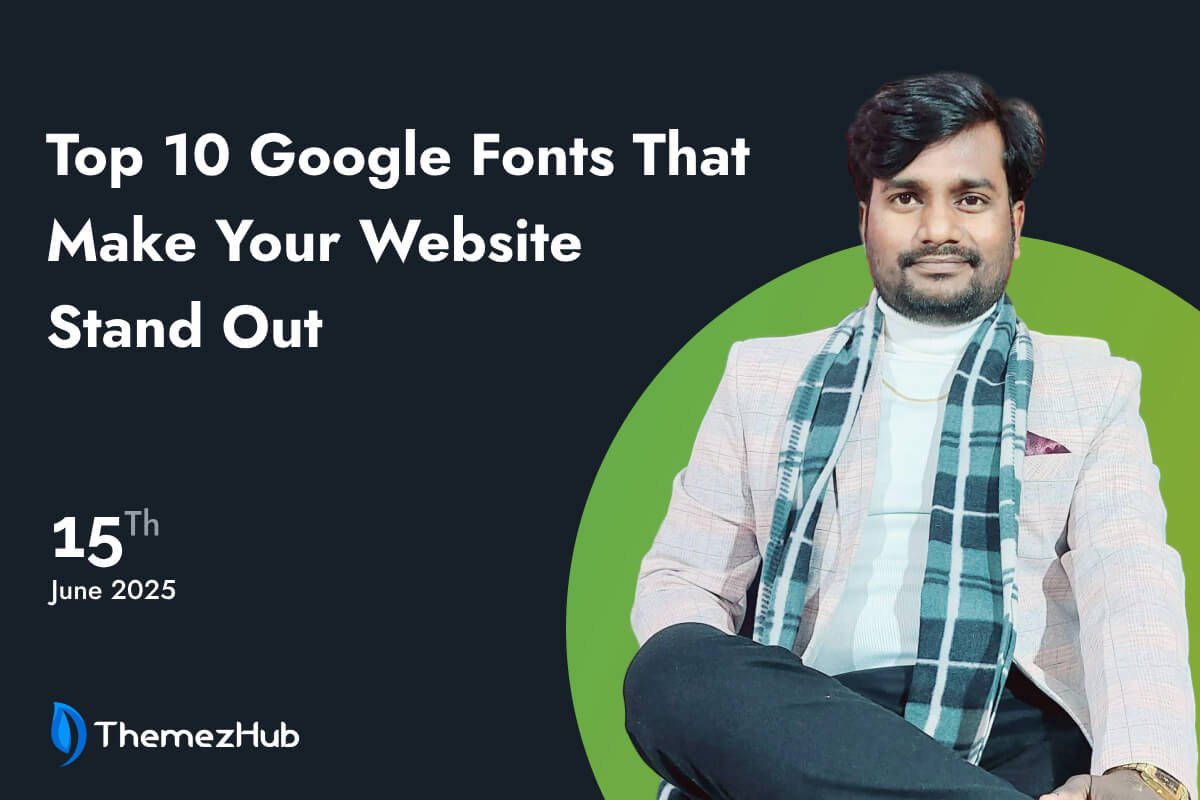When every site uses the same plain text styles your message gets lost in a crowd. Visitors skim quickly and move on before they feel any connection.
That bland look weakens trust and wastes the effort you put into your words. You deserve better than a generic type that blends in with countless others.
The right Google Fonts bring your content to life. With the Google Font API powering over 50 million live websites and having served more than 116 million sites worldwide you gain access to proven typefaces that load fast and captivate at first glance.
In the following sections you will discover which fonts offer crystal clear readability, which ones spark emotion and exactly how to add them to your site in minutes without slowing it down.
Why Fonts Matter for Your Website?
- First Impressions That Stick
When visitors arrive they form an opinion in seconds. A thoughtfully chosen typeface signals professionalism and attention to detail, encouraging users to trust your content.
- Effortless Reading Experience
Well‑designed letter shapes guide the eye along each line. Smooth reading reduces fatigue, keeps novices engaged, and increases the chance they absorb your message.
- Expressing Your Brand’s Voice
Fonts carry emotional weight. A clean sans‑serif whispers modern efficiency. A refined serif evokes tradition and trust. Picking the right style aligns every headline and paragraph with your brand personality.
- Clear Visual Hierarchy
Contrasting font weights and styles creates natural signposts. Readers can scan headings, subheads and body text to instantly find the information they need.
Benefits of Google Fonts
- Vast, Free Library
Hundreds of open‑source fonts spanning playful displays, sturdy serifs and reliable monospaced designs are available at no cost.
- Blazing‑Fast Delivery
Fonts are served from Google’s global CDN so pages load quickly everywhere without extra hosting setup.
- Simple Setup
A single embed link or API call adds new typefaces to your CSS in moments, no complex tooling required.
- Consistent Appearance Everywhere
Google’s hosting guarantees that your chosen fonts render the same across desktop browsers and mobile devices, preserving your design vision.
- Ongoing Improvements
The library grows constantly. Designers push updates, add new weights and expand language support so your site can evolve without extra work.
Top 10 Google Fonts for Your Website
| Font Name | Ideal Use Case | Key Trait | Character |
|---|---|---|---|
| Roboto | Main paragraphs on web | Straight lines | Approachable modern |
| Montserrat | Headlines and banners | Geometric curves | Urban boldness |
| Lora | Blog posts and articles | Subtle serifs | Classic warmth |
| Poppins | Buttons and calls to act | Rounded letters | Friendly invitation |
| Merriweather | Long form reading | High contrast | Comfortable focus |
| Playfair Display | Magazine style headings | Dramatic strokes | Elegant flair |
| Open Sans | User interface text | Neutral shapes | Dependable clarity |
| Raleway | Large title text | Thin lines | Sleek sophistication |
| Nunito | Informal sections | Soft edges | Welcoming tone |
| Source Code Pro | Code snippets and labels | Monospaced design | Technical precision |
1. Roboto
Ideal for body copy and paragraphs where clarity matters most. Roboto’s open letterforms and steady stroke width deliver smooth reading on desktop or mobile.
Why it works?
- At small sizes its generous x‑height keeps letters distinct, reducing eye fatigue.
- Its neutral tone blends with any color palette or layout.
Quick tip
Pair Roboto Regular for text with Roboto Bold for subheads to create a clear hierarchy without loading extra font families.
2. Montserrat
Ideal for attention‑grabbing headlines and section titles. Montserrat’s geometric shapes feel confident and modern.
Why it works?
- Uniform stroke widths make each character pop against backgrounds.
- The tall ascenders (like on “b” and “d”) draw the eye upward, perfect for scanning.
Quick tip
Use Montserrat Semi‑Bold at 32px or larger for main headings, then switch to Roboto or Open Sans for body text to balance personality with readability.
3. Lora
Ideal for long‑form articles, blog posts, and quotes that need a touch of warmth. Lora’s gentle serifs and moderate contrast recall book typography.
Why it works?
- Serif details guide the eye along each line, helping readers stay focused.
- The subtle stroke variation adds elegance without compromising on‑screen clarity.
Quick tip
Combine Lora Italic for pull‑quotes with Lora Regular for paragraphs. This creates visual interest while keeping the tone cohesive.
4. Poppins
Ideal for buttons, calls to action, and interface labels that should feel friendly. Poppins’ perfectly rounded forms invite interaction.
Why it works?
- The circular shapes feel approachable, lowering the barrier to click.
- Consistent letter width ensures UI elements look balanced at any size.
Quick tip
Use Poppins Medium for buttons and Poppins Light for form labels. This contrast highlights interactive elements without adding extra weight.
5. Merriweather
Ideal for extended reading experiences like ebooks, whitepapers, and knowledge bases. Merriweather’s sturdy serifs and high contrast improve legibility over many lines.
Why it works?
- Narrow letter spacing and pronounced serifs anchor each word, reducing visual drift.
- Designed specifically for screens, it maintains sharpness even on lower‑resolution displays.
Quick tip
Set body text in Merriweather Regular at 18–20px, and use Merriweather Bold for subheadings. This scale ensures a comfortable reading rhythm for novices and experts alike.
6. Playfair Display
Ideal for striking section headers, magazine layouts, and brand statements. Playfair Display’s high contrast and refined curves evoke luxury and sophistication.
Why it works?
- Thick and thin strokes create drama that captures attention.
- Tall uppercase letters add a sense of grandeur to titles.
Quick tip
Use Playfair Display Black for main headers and pair with Roboto or Open Sans for body copy to maintain readability.
7. Open Sans
Ideal for user interfaces, navigation menus, and form text where neutrality is key. Open Sans offers a clean, friendly appearance that feels familiar.
Why it works?
- Wide character set supports multiple languages without loss of clarity.
- Balanced proportions make it versatile across contexts.
Quick tip
Combine Open Sans Regular for body text with Open Sans Semi‑Bold for menu items to create subtle emphasis.
8. Raleway
Ideal for large headings, hero sections, and promotional banners. Raleway’s elegant thin lines lend a modern, upscale vibe.
Why it works?
- The sleek letterforms feel airy and sophisticated.
- Thin strokes emphasize minimalism, letting your message shine.
Quick tip
Limit Raleway to sizes above 48px to avoid legibility issues, and use a sturdier body font like Lora or Merriweather.
9. Nunito
Ideal for friendly interfaces, testimonials, and community‑focused pages. Nunito’s soft, rounded edges create a welcoming atmosphere.
Why it works?
- Gentle curves reduce visual tension, making text feel approachable.
- Even weight distribution ensures consistency across headings and paragraphs.
Quick tip
Pair Nunito Bold for user testimonials with Nunito Regular for supporting text to maintain a warm, unified look.
10. Source Code Pro
Ideal for code snippets, technical documentation, and developer blogs. Source Code Pro’s monospace design highlights structure and precision.
Why it works?
- Each character occupies the same width, making indentation and alignment clear.
- Distinct punctuation marks improve readability of code samples.
Quick tip
Use Source Code Pro at 14px with a contrasting background block to set code apart from regular content.
Conclusion
Every font choice shapes how readers feel and act. To put this into practice pick one heading font and one body font from the list. Check load times in your browser’s developer tools to confirm performance stays under 200 ms. Within days you’ll see which combinations boost readability and engagement. Armed with those insights, you can fine‑tune spacing, weight and size to guide visitors exactly where you want them. That hands-on testing turns simple type choices into measurable growth.






